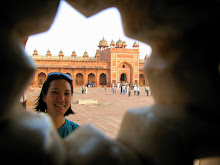My co-worker’s husband passed away in early December of lung cancer. He was really young, in his forties, and they have two kids in elementary school. They had a Buddhist funeral at a temple in Bangkok, with monks chanting and giving speeches in Burmese. A guy sitting next to me, a friend of the family, told me that the monks were talking about how life is impermanent and that we should be at peace with death.
At the end of the ceremony, a bunch of the male guests carried the coffin out to the crematorium, which was on the same compound. When I saw them carrying the coffin into the crematorium, my breath imploded into itself. It seemed so final, watching them go up the steps with the coffin, knowing that soon there would be nothing left of the guy except memories and photos.
It also seemed too soon. He had only passed away the day before.
I looked over at my co-worker, his widow, who was keeping it together really well. She and the kids just watched matter-of-factly. Maybe it’s because they are Buddhist, and when you’re Buddhist you know that cremation is part of how you die.
Even though a lot of people in the U.S. get cremated these days, I think the idea of burial and keeping the body around is pretty ingrained in us. I see it as one of the ways our culture tries to avoid the impermanence of everything in life, including life itself. At that moment, surrounded by all my Thai and Burmese co-workers, nearly all of whom are Buddhist, I felt like the least enlightened person in the crowd, with a knot in my stomach knowing that this guy was soon to be a pile of ashes.
Someone flipped a bunch of switches in the crematorium and there were these dramatic whooshing sounds, like pilot lights for a massive, industrial-sized stove. The fire was going. I think that most Asian cultures are all about not showing emotions, which added to the discomfort I felt with everyone around me watching almost impassively as the carriers slid the coffin into the, well, oven.
There was a tray of straw flowers at the foot of the steps leading into the crematorium. One by one we each took a flower and filed into the building. We put our flower into the fire next to the coffin, which was still intact except for a black spot that was starting to grow as one corner caught fire and burned. People wai'd the deceased as a show of respect, placing their hands together in front of their face in a prayer gesture. We continued out the door on the opposite side of the crematorium.
I asked another co-worker, our HR director, how long it usually takes for the cremation to be complete. I’m pretty sure I had to rephrase the question a few times. “How long does it usually take to burn the body? To burn away the coffin? How long does it take…ugh.”
“A few hours,” he said kindly. Thank God Thai people are so polite.
One reason I had asked was because even though the crematorium had been built with a tall chimney, I wanted to make sure to leave the compound before I started thinking there was someone selling barbeque from a food cart. Terrible. Terrible. Terrible.
What does a museum mean here?
1 day ago




No comments:
Post a Comment